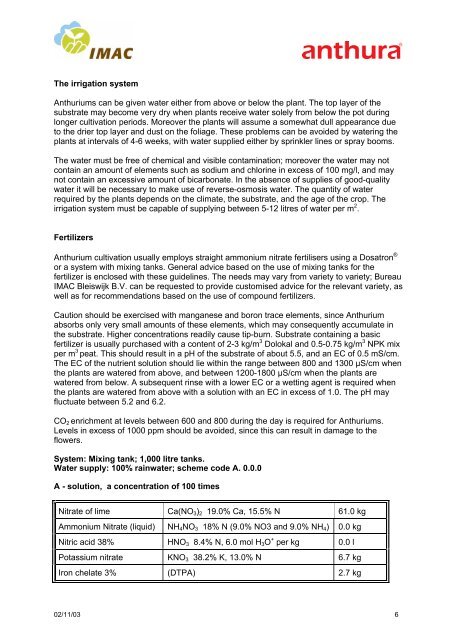Pot Anthurium cultivation guidelines - Sprint Horticulture
Pot Anthurium cultivation guidelines - Sprint Horticulture
Pot Anthurium cultivation guidelines - Sprint Horticulture
Create successful ePaper yourself
Turn your PDF publications into a flip-book with our unique Google optimized e-Paper software.
The irrigation system<br />
<strong>Anthurium</strong>s can be given water either from above or below the plant. The top layer of the<br />
substrate may become very dry when plants receive water solely from below the pot during<br />
longer <strong>cultivation</strong> periods. Moreover the plants will assume a somewhat dull appearance due<br />
to the drier top layer and dust on the foliage. These problems can be avoided by watering the<br />
plants at intervals of 4-6 weeks, with water supplied either by sprinkler lines or spray booms.<br />
The water must be free of chemical and visible contamination; moreover the water may not<br />
contain an amount of elements such as sodium and chlorine in excess of 100 mg/l, and may<br />
not contain an excessive amount of bicarbonate. In the absence of supplies of good-quality<br />
water it will be necessary to make use of reverse-osmosis water. The quantity of water<br />
required by the plants depends on the climate, the substrate, and the age of the crop. The<br />
irrigation system must be capable of supplying between 5-12 litres of water per m 2 .<br />
Fertilizers<br />
<strong>Anthurium</strong> <strong>cultivation</strong> usually employs straight ammonium nitrate fertilisers using a Dosatron ®<br />
or a system with mixing tanks. General advice based on the use of mixing tanks for the<br />
fertilizer is enclosed with these <strong>guidelines</strong>. The needs may vary from variety to variety; Bureau<br />
IMAC Bleiswijk B.V. can be requested to provide customised advice for the relevant variety, as<br />
well as for recommendations based on the use of compound fertilizers.<br />
Caution should be exercised with manganese and boron trace elements, since <strong>Anthurium</strong><br />
absorbs only very small amounts of these elements, which may consequently accumulate in<br />
the substrate. Higher concentrations readily cause tip-burn. Substrate containing a basic<br />
fertilizer is usually purchased with a content of 2-3 kg/m 3 Dolokal and 0.5-0.75 kg/m 3 NPK mix<br />
per m 3 peat. This should result in a pH of the substrate of about 5.5, and an EC of 0.5 mS/cm.<br />
The EC of the nutrient solution should lie within the range between 800 and 1300 µS/cm when<br />
the plants are watered from above, and between 1200-1800 µS/cm when the plants are<br />
watered from below. A subsequent rinse with a lower EC or a wetting agent is required when<br />
the plants are watered from above with a solution with an EC in excess of 1.0. The pH may<br />
fluctuate between 5.2 and 6.2.<br />
CO2 enrichment at levels between 600 and 800 during the day is required for <strong>Anthurium</strong>s.<br />
Levels in excess of 1000 ppm should be avoided, since this can result in damage to the<br />
flowers.<br />
System: Mixing tank; 1,000 litre tanks.<br />
Water supply: 100% rainwater; scheme code A. 0.0.0<br />
A - solution, a concentration of 100 times<br />
Nitrate of lime Ca(NO3)2 19.0% Ca, 15.5% N 61.0 kg<br />
Ammonium Nitrate (liquid) NH4NO3 18% N (9.0% NO3 and 9.0% NH4) 0.0 kg<br />
Nitric acid 38% HNO3 8.4% N, 6.0 mol H3O + per kg 0.0 l<br />
<strong>Pot</strong>assium nitrate KNO3 38.2% K, 13.0% N 6.7 kg<br />
Iron chelate 3% (DTPA) 2.7 kg<br />
02/11/03 6


